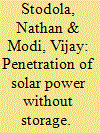|
|
|
Sort Order |
|
|
|
Items / Page
|
|
|
|
|
|
|
| Srl | Item |
| 1 |
ID:
119913


|
|
|
| 2 |
ID:
127257


|
|
|
|
|
| Publication |
2014.
|
| Summary/Abstract |
Combined Heat and Power (CHP) has been proven as a mature technology that can benefit both building owners and utility operators. As the economic and environmental benefits of CHP in urban centers gain recognition, regulations and policies have evolved to encourage their deployment. However, the question remains whether these policies are sufficient in helping to achieve the larger sustainability goals, such as the New York City-specific goal of incorporating 800 MW of distributed generation. In this paper, the current regulatory and policy environment for CHP is discussed. Then, an engineering analysis estimating the potential for CHP in NYC at the individual building and microgrid scale, considered a city block, is performed. This analysis indicates that over 800 MW of individual building CHP systems would qualify for the current incentives but many systems would need to undergo more cumbersome air permitting processes reducing the viable capacity to 360 MW. In addition microgrid CHP systems with multiple owners could contribute to meeting the goal even after considering air permits; however, these systems may incorporate many residential customers. The regulatory framework for microgrids with multiple owners and especially residential customers is particularly uncertain therefore additional policies would be needed to facilitate their development.
|
|
|
|
|
|
|
|
|
|
|
|
|
|
|
|
| 3 |
ID:
091584


|
|
|
|
|
| Publication |
2009.
|
| Summary/Abstract |
Infrastructure planning for networked infrastructure such as grid electrification (or piped supply of water) has historically been a process of outward network expansion, either by utilities in response to immediate economic opportunity, or in response to a government mandate or subsidy intended to catalyze economic growth. While significant progress has been made in access to grid electricity in Asia, where population densities are greater and rural areas tend to have nucleated settlements, access to grid electricity in Sub-Saharan Africa remains low; a problem generally ascribed to differences in settlement patterns. The discussion, however, has remained qualitative, and hence it has been difficult for planners to understand the differing costs of carrying out grid expansion in one region as opposed to another. This paper describes a methodology to estimate the cost of local-level distribution systems for a least-cost network, and to compute additional information of interest to policymakers, such as the marginal cost of connecting additional households to a grid as a function of the penetration rate. We present several large datasets of household locations developed from satellite imagery, and examine them with our methodology, providing insight into the relationship between settlement pattern and the cost of rural electrification.
|
|
|
|
|
|
|
|
|
|
|
|
|
|
|
|
| 4 |
ID:
092793


|
|
|
|
|
| Publication |
2009.
|
| Summary/Abstract |
If solar power is to provide substantial portions of our electricity needs, it will first become cost effective when it provides peak power in the daytime, without the need for storing the energy. Indeed since human electricity consumption is frequently small at night and larger when the sun is shining, there is already a natural correlation. Existing power systems are currently geared to provide this variable demand, with baseload plants cheaply providing a constant level of power, and dispatchable plants dynamically (and more expensively) supplying the rest. This leads to the frequent suggestion that one can exploit the correlation between sunlight and electricity by using energy from solar panels during the day to offset some of the load previously generated by dispatchable plants.
This paper addresses the question of how much of the load can be substituted by the solar electricity, without leaving the solar power plant substantially idle or requiring the solar power to be stored. It uses historical sunlight and electrical load data from 32 regions of the United States to determine the photovoltaic (PV) power generation capacity that could be installed such that "almost all" of its energy output would occur at times of high demand. Specifically, what is the maximum deployment that permits 95% of the annual output from PV to be utilized without reducing the output of the baseload plants?
Our results for these 32 regions are that 7.8% of the total annual electricity demand could be met by installing 59 GW of PV panels. This represents about a fourth of the present electrical energy supplied by dispatchable plants. If solar power were equally effective in the rest of the United States, nearly 200 GW of PV capacity could be put to use without any energy storage. Thus, in the near term, there is enormous room for expanding the roughly 1 GW installed base of PV power without investing in night-time energy storage. The paper also provides insight into how year-to-year variability of sunlight and demand impact the results.
|
|
|
|
|
|
|
|
|
|
|
|
|
|
|
|
|
|
|
|
|